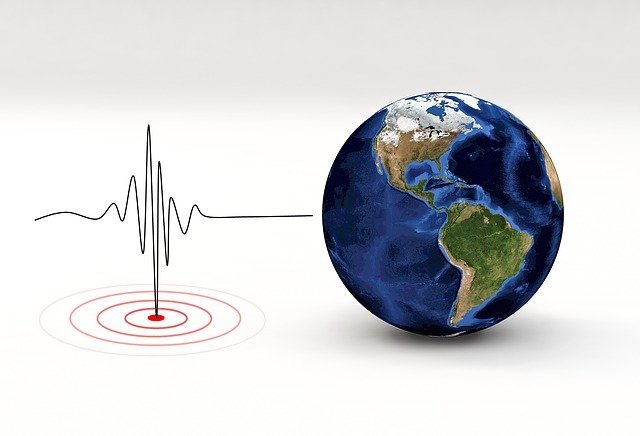Earthquakes are releases of energy accumulated in the rocks of the Earth's crust or in the upper zones of the Earth's mantle, resulting in a rapid shift of rock masses. This is accompanied by violent shocks, often of destructive force, caused by seismic waves. The place where the earthquake originated is the epicenter of the earthquake. The location directly above the epicenter of an earthquake is the hypocenter where it is felt most.
The strongest earthquakes of natural origin are of the tectonic type. In addition, earthquakes can be caused by the collapse of chambers of karst origin, volcanic ones related to volcanic eruptions and anthropogenic origin - e.g. the detonation of an atomic bomb. Interestingly, the types of seismic waves on the seismograph chart shows whether the earthquake caused is anthropogenic or natural.
The earth consists of several layers. In a simplified way, we can distinguish the Earth's core, the Earth's mantle, and the outermost layer on which we live is the Earth's crust. The apparently constant and unchanging crust of the Earth is "cut" into many fragments called tectonic plates. These plates are in constant motion so they often move away from each other, collide with each other or rub against each other. In places of collision and friction between these plates, stresses between the rock masses. These tensions are discharged in the form of earthquakes. We can distinguish such tectonic plates as the North American plate, the South American plate, the Pacific plate, the African plate, the Australian plate, and the Eurasian plate. An example of the friction of two plates against each other is the famous San Andreas fault in California, where frequent earthquakes occur as a result of friction between two Pacific and North American plates. An example of a collision of two plates is the collision of the denser and heavier oceanic pacific plate which, in the area of the coasts of the Japanese islands, plunges under the lighter continental Euro-Asian plate.
Earthquakes are devastating and very dangerous. Watch out for yourself in earthquake regions :)
^^^^^^^^^^^^^^^^^^^^^^^^^^^^^^^^^^^^^^^^^^^^^^^^^^^^^^^^^^^^
Trzęsienia Ziemi są to uwolnienia energii nagromadzonej w skałach skorupy Ziemskiej bądź górnych strefach płaszcza Ziemi wskutek których następuje gwałtowne przemieszczenie się mas skalnych. Towarzyszą temu gwałtowne wstrząsy często o niszczycielskiej sile wywołane przez fale sejsmiczne. Miejsce powstania trzęsienia Ziemi to epicentrum trzęsienia Ziemi. Miejsce znajdujące się bezpośrednio nad epicentrum trzęsienia Ziemi to hipocentrum gdzie jest ono najbardziej odczuwalne.
Najsilniejsze trzęsienia ziemi naturalnego pochodzenia są trzęsieniami typu tektonicznego. Oprócz tego trzęsienia ziemi mogą być wywołane przez zapadanie się komór o genezie krasowej, wulkaniczne związane z erupcjami wulkanów i pochodzenia atropogenicznego - np detonacja bomby atomowej. Co ciekawe po rodzajach fal sejsmicznych na wykresie sejsmografu możemy stwierdzić czy wywołane trzesięnie ziemi jest pochodzenia antropogenicznego czy naturalne.
Ziemia składa się z kilku warstw. W dużym uproszczeniu możemy wyróżnić jądro Ziemi, płaszcz Ziemi oraz najbardziej zewnętrzną warstwę na której żyjemy to skorupa Ziemi. Skorupa Ziemi pozornie stałą i niezmienna jest "pocięta" na wiele fragmentów nazywanych płytami tektonicznymi. Płyty te są w nieustannym ruchu so powoduje że często oddalają się od siebie, kolidują ze sobą bądź trą o siebie. W miejscach kolizji i tarcia między tymi płytami dochodzi do naprężęń między masami skalnymi. Napięcia te są rozładowywane w postaci trzęsień Ziemi. Możemy wyróżnić takie płyty tektoniczne jak płyta północno amerykańska, płyta południowo amerykańska, płyta pacyficzna, płyta afrykańska, płyta australijska oraz płyta euroazjatycka. Przykładem tarcia o siebie dwóch płyt jest słynny uskok San Andreas w Kaliforni gdzie wskutek tarcia o siebie dwóch płyt pacyficznej i północno- amerykańskiej dochodzi do częstych trzęsień ziemi. Przykładem kolizji dwóch płyt jest kolizja gęstszej i cięższej oceanicznej płyty pacyficznej która w rejonie wybrzeży wysp japońskich zanurza sie pod lzejszą kontynentalną płytą euroazajatycką.
Trzęsienia Ziemi są niszczące i bardzo niebezpieczne. Uważajcie na sibie w rejonach trzęsien Ziemi :)

Congratulations @elendeil! You have completed the following achievement on the Hive blockchain and have been rewarded with new badge(s) :
Your next target is to reach 20 posts.
You can view your badges on your board and compare yourself to others in the Ranking
If you no longer want to receive notifications, reply to this comment with the word
STOPTo support your work, I also upvoted your post!
Than you
You are welcome @elendeil! It is great to see you are doing your first steps! Great work!